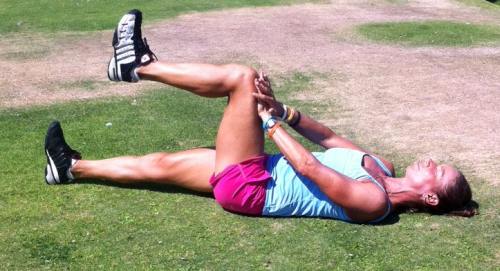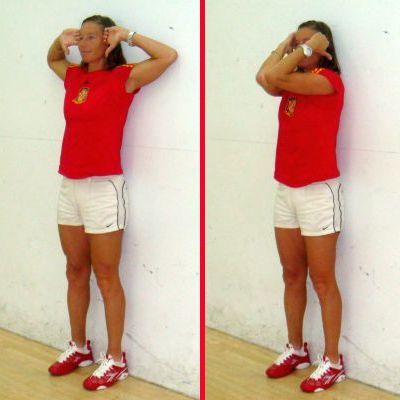Injuries are not fun. They can sideline you from training for long time. The two kinds of injuries are acute and overuse injuries. Acute injuries happen when you fall, twist, or break something, or somebody or something hits you. Acute injuries are easy to notice, because they hurt, swell, or bleed, and you need an immediate medical attention. The other type of injuries is an overuse injury, sometimes called stress injury. They develop over time with many traumas and they “sneak” on you. The overuse injuries can happen from doing too much, too soon, to fast, too hard, too intense, or too “something” that your body is not conditioned for. You start feeling a little irritation or pain that you tend to ignore with words “no pain, no gain” or “it’s part of the process,” and eventually you may get some swelling, inflammation or daily pains and aches.
The best approach to prevent overuse injuries is by being physically fit, evenly flexible and strong in both left and right side of your body, strong in your core, and having good balance. You need to train smart with proper periodization, eat healthy nutrition, and eliminate as much stress as possible. Additionally, you need to use good quality equipment and shoes. That is a lot to think about, especially if you also work, have family and other obligation.
Where do you start? The core and hips are the most important part of your athletic body. You use your core and hips in any athletic movement to transfer the forces between the lower and upper body. Any imbalances in your core or hips will cause uneven forces on other muscle groups and joints, and over time create overuse injuries. Therefore, a good start in your physical well-being and injury-free training is to look at your hips. You want to keep the hips balanced and equally strong and flexible on both sides.
The lopsided nature of tennis and our lifestyle creates small imbalances in our hips that are hard to spot, unless you search for them. The open-stance forehand, close-stance backhand, serving (one side only), driving your car (using your right leg most of the time), and many more daily activities that we do, support the developing imbalances. The most common problem in your hips is rotational misalignment — one hip is rotated forward, the other backward. This very common condition can create many other symptoms, such as piriformis syndrome (often mistaken for “sciatica”), pain in the patella (front of the knee), plantar fasciitis (pain on the bottom of foot/heel), excessive foot pronation, groin strain, IT band syndrome, and hamstring strain.
![]()
How do you know if your pelvis is misaligned? Compare your left and right side and see if it is harder to balance on one side, if one side is weaker, more painful, tighter, or stiffer. If any of this is true, your pelvis may be rotated. Another test is to lie on your back on the floor, bring your knees to your chest, and then slowly stretch them straight. Have a friend observe if you have one leg longer than then the other leg. In about 80-85% of the right-handed tennis players, if there is a pelvic rotation, the right leg is longer than the left leg. While you are on the floor on your back with straight legs, have your friend check if your hipbones are level. Often, the right hipbone will appear lower than the left one. Similar check can be performed from the back, when you lie on your stomach and your friend checks the level of your hipbones. Most often, the right hipbone appears to be higher than the left one, if the pelvis is rotated.
This rotation of your hips can happen during the aggressive movements on the tennis court or in the intense training sessions, where the many muscles of the hips are pulling in different directions. If you have imbalances in strength or flexibility in these muscle groups, then the forces are even more uneven. If you find the hip misalignment subject interesting, you can find more in Wolf Schamberger’s book “The Malalignment Syndrome: Implications for Medicine and Sports.”
Isometric exercise to self-correct your hip misalignment
1) Lie on your back with straight legs.
2) Lift your right leg, bend your knee, and hook your hands behind your knee.
3) Push your right leg away from your chest into your hands that are resisting the pull. Use about 30% of your power and hold the position for 6 seconds, then put your right leg down on the floor.

4) Lift your left leg, bend your knee, and place your hands on the top of your left thigh.
5) Push your left knee at 30% of your power toward your chest and against your hands. Hold for 6 seconds, then switch sides again.

6) Repeat 6 times on each side.
If your pelvis has been rotated for long time and the muscles are very shortened, this self-correction exercise may not help you. You should consult with a sport physical therapist or other skilled specialist. If your condition is light, you will benefit from this quick isometric exercise. Learn how to recognize the imbalances early, so you can help yourself on your own, without getting too much pain and subsequent need of professional help.
Remember that you must work on strengthening your core regularly to keep it fit and strong. After each training or tennis session, perform a thorough stretching routine. If your body has more aches and imbalances, you need to set some time aside for a good self-myofascial release routine to get rid of the pesky painful trigger points.
![]()
If you find this article helpful for your athletic performance, remember that you have friends that may be in pain too… Help your friends by sharing this article with them. Lets hope that they won’t thank you by beating you on the tennis court next time because they feel so great.
![]()
New Product on Mental Toughness
Have you lost matches that you clearly should win, or you thought you would win? What happened? What is happening to Rafa’s mental toughness now when he lost a number of times to players he is not used to losing? The mental game is so important, yet we don’t pay enough attention to it. I’ve had a good conversation with the mental game expert David Breslow. David has 25 years experience in the tennis business, 13 as a competitive player, Director of Mental Toughness at the USTA National Tennis Center (site of the U.S. Open) Ivan Lendl’s Grand Slam Tennis, National Junior Reebok Training Center and Teaching Professional. In addition, for the last 20 years, he has been a Mental Game Performance Coach helping tennis players of all levels around the world and teaches them how to think, feel and do things better when they play.
David’s has developed many products, with his newest one called, “Match-Tough: Practice Great and Play Even Better!” It directly answers the most often asked question: “How do I take my practice game into competition?” What separates David from the majority are his insights and conversation. Without any psychological rhetoric or the need for the usual quick-fix tips (“be confident, positive and make sure your body language is strong”), David takes you on an active journey that includes exercises after each module that will blow you away. It’s incredible how these simple, yet transforming insights can help you become clearer, more confident and see yourself and the game through new eyes—and these changes begin immediately in module 1.
The “Match Tough” product is an online audio/video slide presentation (about 2.5 hours) in 4 timely delivered modules that will change your view of the mental game forever. It includes a 30+ page study guide and 7 other bonuses to add to your learning. The price is affordable. If you are interested in improving your competitive toughness, grab your “Match Touch” here. Get strong, get flexible, get tough!
![]()
Other good articles to consider reading if you want to improve your tennis fitness:
Kettlebell training for tennis players – basic kettlebell swing (great for cardio, core and leg strength)
Kettlebell workout video for inspiration (explosive power is very important for tennis players)
Stiff-legged deadlift for strong hamstrings (very important for tennis players, as our hamstrings are often weaker than the quadriceps, causing injuries, tightness and slowness on the court)




